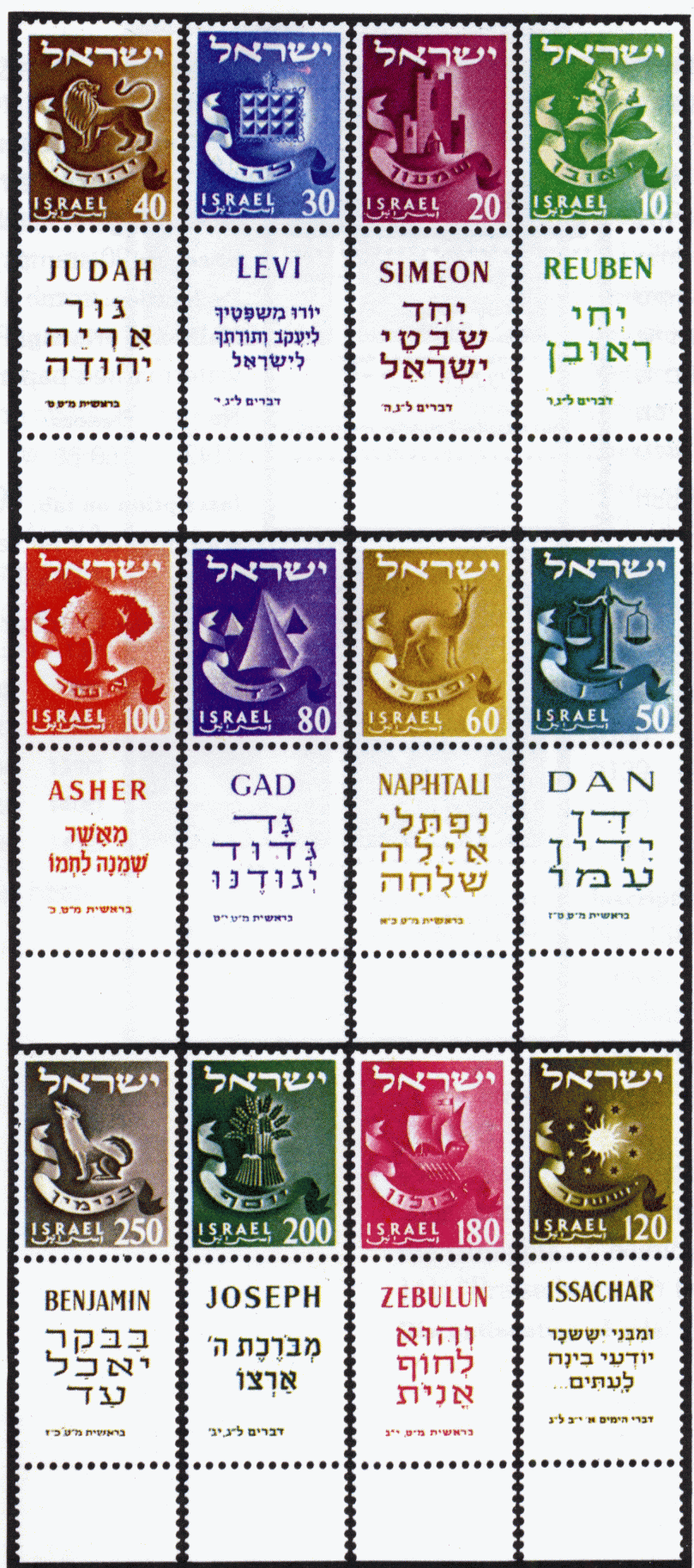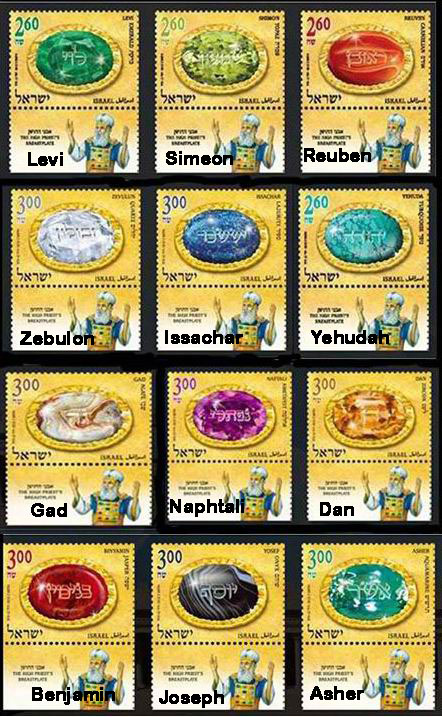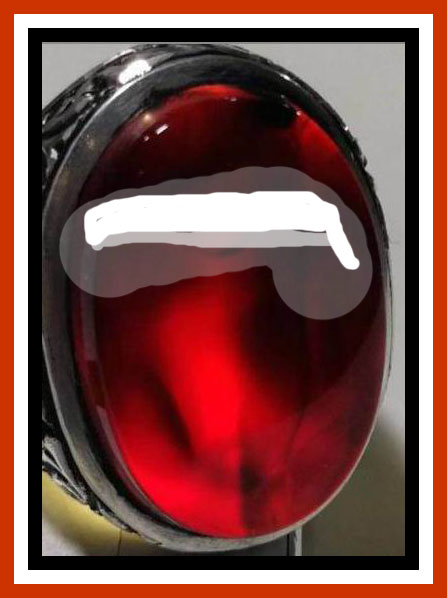Individual Colors, Gem Stones, and Symbols Attributed to Each of the Tribes of Israel
See Also: Breastplate.

The Order of the Tribes on the Breastplate of the High Priest went from left to right i.e. in the same direction as the Hebrew Script.

This article may also be considered another instalment in our Weekly Portion Series. Parashah Pekudi, Exodus 28:31, 39, 40.
This is the last portion in the Book of Exodus. It deals with the Tabernacle. The Tabernacles was the precursor and prototype for the Temple.
RED, WHITE, AND BLUE
Rabbi Shimshon Rafael Hirsch point out that the predominant colors for the Tabernacle were blends of red, blue, and white.
These are the colors of Israel in general.
They are also the colors of major Israelite nations such as the UK, USA, and France. Also of Australia, and New Zealand.
Additional Notes:
The Breastplate of the High Priest has a misleading name. When one hears the term "Breastplate" then some type of brass armoring over the chest is liable to come to mind. In fact the Breastplate ("Hoshen" in Hebrew) was actually made of woollen and linen intertwined fabric with a reinforcement of thing strands of gold. It was only about 8 inches (or less) square. Gold containers were encased within it in each of which was a different gem stone. There were four rows with 3 gems in each one. The gem stones had the names of the Tribes engraved upon them.
IN ADDITION, Maimonides (1135-1204, Spain, Egypt) says: On the Ruby stone of Reuben as well as the name of Reuben were also to be found the names Abraham, Isaac, and Jacob. On the stone of Naphtali in addition to the name "Naphtali" the expression"Tribes of Yah" (Psalms 122:4) was also to be found.
cf.
Psalms (NLT) 122:
A song for pilgrims ascending to Jerusalem. A psalm of David.
1 I was glad when they said to me,
'Let us go to the house of the LORD.'
2 And now here we are,
standing inside your gates, O Jerusalem.
3 Jerusalem is a well-built city;
its seamless walls cannot be breached.
4 All the tribes of Israel, the LORD's people,
make their pilgrimage here.
They come to give thanks to the name of the Lord,
as the law requires of Israel.
5 Here stand the thrones where judgment is given,
the thrones of the dynasty of David.
6 Pray for peace in Jerusalem.
May all who love this city prosper.
7 O Jerusalem, may there be peace within your walls
and prosperity in your palaces.
8 For the sake of my family and friends, I will say,
'May you have peace.'
9 For the sake of the house of the LORD our God,
I will seek what is best for you, O Jerusalem.
The Commentary "Chizkuni" (ca. 1310 CE, France) differs from Maimonides on this matter. He says the names of the Patriarchs (Abraham, Isaac, and Jacob), the names of the 12 Tribes, and the words "Tribes of Yeshurn" were written upon the stones in such a way that each stone contained 6 letters,
Deuteronomy (NIV) 33:
5 He was king over Jeshurun when the leaders of the people assembled, along with the tribes of Israel.
ABOVE are a set of Israeli stamps showing the Gem Stones of each Tribe. This is based on Midrash Numbers Rabah 2;5. This is also the order accepted by Rashi (Rabbi Shlomo Yitzchaki, 1040 - 1105, Troyes, France) who is usually accepted as quite authoritative. We also accept this Midrash even though other opinions exist concerning which Tribe had which stone, and what the stones and their colors really were.
The Midrash Rabah explanation is most consistent with other information we have on this matter. The pictures are show from right to left (like Hebrew writing) as they would have been in reality.
Reuben has a red stone identified as a Ruby, or as a Topaz. In Hebrew it is "Odem" meaning "red." The word ruby also means red. "Ruby" in English in English and French is also short for Reuben. The symbol of Reuben was a picture of mandrakes. The mandrakes were a plant that resembled a man or the organ of a man. They have a flower which wihie or slighlty pink and resembles the fleur-de-lis lily symbol of France. We identify Reuben as mainly being among the French people.
Simeon has the Pitedah stone which is yellowish. Others say it was an emerald and the color of green. The national color of Ireland is green. Wales has a combination of Green, red, and white. Descendants of Simeon were scattered throughout the other Tribes but may have had especially large concentrations in Ireland and Wales. This is indicated in the names of Tribes found in those areas as well as in Brittany in Western France. These three areas are known for their "Celtic" type languages and culture. A strongly pronounced Hebrew substructure is present in these tongues. The symbol of Simeon was a depiction of the city of Schechem that Simon and his brother, Levi, conquered. The depiction is often that of a castle or the entrance to a fortified city.
Levi has the "bareket" stone whose name connotes flashing lightning. The Midrash says it had three vertical stripes of red, black, and white. Others say it was greenish.
https://en.wikipedia.org/wiki/Priestly_breastplate
According to the Midrash Rabba (Numbers Rabba 2:7), the stone called bareket had veins or parallel bands of colours white, black and red running through it, suggesting that it may have actually been a kind of agate or onyx. This may explain why in some French translations the word is rendered as 'agate'. In the South Arabian dialect spoken in Yemen during the Middle Ages, bakarani (believed to be a corruption of barkan) was an exceptionally beautiful and rare onyx stone mined on Mount Anis, in Yemen, one variety of which having a red surface with a vein of white over another of black running through it.[Note 2] Symmachus, an ancient Jewish translator whose Greek translation of the Pentateuch appeared in Origen's Hexapla, has also written "Keraunios", literally meaning 'of a thunderbolt', and a more direct translation of the stone known in Hebrew as bareket relating to barak 'lightning' in Exodus 28:17. Jerome, however, understood the Greek word to mean "onyx."

Picture Adapted from:
https://www.gemstonechronicle.com/product/yemeni-aqeeq-stone/ Depicts a type of agate jewel produced in Yemen.
Yehudah has the stone known as "Nofech," probably a light blue, perhaps a bluish carbuncle commonly taken to mean a garnet.
"In classical rabbinical literature there is some debate between whether Nofekh was red or greenish blue; Exodus Rabbah and the second Jerusalem Targumfavour it being red, while the Babylonian Targum and first Jerusalem Targum favour it being green.[1] "
The symbol of Judah is a lion.
All of the Tribes, in addition to something else, had their own symbolic animal but most of them are not known to us.
Issachar is a "Sapir" i.e. a sapphire, usually taken to be dark blue in hue. The symbol of Issachar is a grouping stars with the sun and moon. This represented astronomical calculations in which Issachar excelled. See: Issachar Saphire articles/tribes/issacharstone.html
http://hebrewnations.com/articles/tribes/issacharstone.html
Zebulon has a "Yaholam" understood to be a a pearl, or a diamond. His color is white. Zebulon dominated the Netherlands.
Dan has a stone known as a leshem. This was also the name of a major city of Dan before the Danites conquered it. The Leshem may have been the amber stone or another gem of similar color. The color is creamy yellow, or yellow, or orange. One authority say the color of Dan was black. The symbol of Dan was a serpent.
^^^^^^^^^^^^^^^^^^^
NOTE: Change in opinion. The two stones below (of naphtali and Gad) have been switched. Gad should have the pinkish achlomah and Naphtali the gry agate.
The stone of Naphtali was an achlomah whose color appears to have been some kind of mixture of red and white, perhaps pink. Purple is also a possibility. The symbol of Naphtali is often given as a doe i.e. a female deer. An antelope may be more exact. or a type of wild goat.
Gad had the stone known as "Shevo." Its color was greyish or a silber or blackish color.
^^^^^^^^^^^^^^^^^^^
Asher has a stone known as "Tarshish." Tarshish was also the name of Tartessos near Gibraltar on the southwest coast of Spain facing the Atlantic. Tarshish was also a name applied to the Atlantic Ocean in general. The standard of Asher depictied an olive tree and Asher was associated with olive oil. The color of Asher appears to have been a light aquamarine.
Previously we attributed the Leshem stone to represent Asher but we have since we revised our opinion on this matter and ascribe it to Dan.
http://www.britam.org/tribes/DanTC.html
http://www.britam.org/tribes/AsherTC.html
^^^^^^^^^^^^^^^^^^^
Joseph had the Shoham stone. This is often identified with the onyx or sardonymx. the color was black though one authority says dark green. Some say dark sea-green or dark blue. Another opinion says instread of black the color white. There is also a Rabbinical opinion that white and black could interchange. The symbol of Joseph was a according to the Midrash was a picture representing Egypt, possibly a pyramid similar to that now found on the US Great Seal depicted on the dollar bill. A sheaf of wheat. The banner of Joseph was black. Joseph was divided into two: Manasseh and Ephraim. A RAEM (unicorn) represented Manasseh and a bull was the symbol of Ephraim. The very name for "England" derived from a Hebrew Word (Aegel pronounceable as "Angel") meaning "bull-calf" and a nickname for Ephraim (Jeremiah 31:18). Other symbols attributed to Joseph include a sheaf of wheat, lamb, a palm tree, a well of water, and a climbing grape vine.
Benjamin had the colors of the Rainbow. The stone of Benjamin in Hebrew was called a "yashpeh" identified with the jasper. Some forms of the jasper stone (a variety of Chalcedon) are indeed multi-colored. The symbol of Benjamin was a wolf.
See Also:
See Also:
Priestly breastplate. https://en.wikipedia.org/wiki/Priestly_breastplate
URIM AND THUMMIM. http://hebrewnations.com/articles/bible/urim.html
Issachar Saphire. http://hebrewnations.com/articles/tribes/issacharstone.html
Tribal Characteristics in a Nutshell. http://www.britam.org/tribes/TribecharList.html
